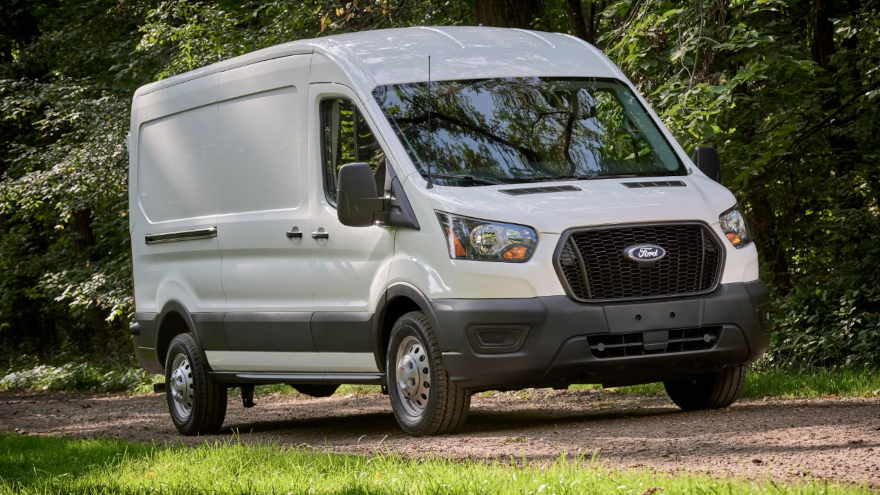‘Subtle yet significant’ trends involving commercial vehicles surface in Q3

2021 Ford Transit. Image courtesy of the automaker.
By subscribing, you agree to receive communications from Auto Remarketing and our partners in accordance with our Privacy Policy. We may share your information with select partners and sponsors who may contact you about their products and services. You may unsubscribe at any time.
Work Truck Solutions said the interplay between the new and used segments of commercial vehicles reveals a series of “subtle yet significant” indicators that warrant attention.
That’s the primary finding from its Q3 2024 Commercial Vehicle Market Analysis, which indicated the commercial vehicle market overall is continuing to recover.
Work Truck Solutions reported that new work truck inventory continued to climb in the third quarter, with increases of 5.8% quarter-over-quarter and 39.7% year over year
Conversely, the company found that used truck inventory decreased by 6.0% quarter-over-quarter and 15.7% year-over-year.
“The diminished used-vehicle inventory is as expected due to previous years of slow new truck sales,” Work Truck Solutions said in a news release. “The forecast for new commercial vehicles to begin appearing in the used market in significant numbers is three to five years. This aligns with typical lease terms and company fleet replacement cycles.
Looking at retail prices, Work Truck Solutions indicated the stickers for new models ticked up 0.8% on a sequential basis and 1.0% year-over-year.
Subscribe to Auto Remarketing to stay informed and stay ahead.
By subscribing, you agree to receive communications from Auto Remarketing and our partners in accordance with our Privacy Policy. We may share your information with select partners and sponsors who may contact you about their products and services. You may unsubscribe at any time.
Meanwhile, retail prices for used work truck prices softened, according to Work Truck Solutions, falling by 1.7% compared to the previous quarter and 9.0% from a year ago. Work Truck Solution said that’s “likely due to the increasing mileage of unsold used vehicles.”
Speaking of mileage, Work Truck Solutions reported used work truck mileage continued to rise, with the average mileage of sold units increasing by 4.3% quarter-over-quarter and 5.8% year-over-year.
“Again, this upward mileage trend is expected to continue until enough new vehicles become ripe for remarketing, raising available used inventory and also impacting median mileage,” analysts said.
Work Truck Solutions pointed out that sales of new work trucks continued modest growth with an increase of 9.9% quarter-over-quarter and 5.2% year-over-year.
“Within the light and medium-duty segment, which makes up the lion’s share of sales, pickups, empty cargo vans, and passenger vans led the charge,” analysts said.
Conversely, Work Truck Solutions found that used truck sales declined by 1.3% in Q3 compared to last quarter and 7.4% year-over-year.
“However, when examining a two-year snapshot of work truck sales, we see used vehicle sales numbers that mimic the overall availability trends,” Work Truck Solutions said. “In contrast, new-vehicle sales remain closer to pandemic levels even though new vehicle inventory continues to rise sharply. This is due to the rapid increase in interest rates, concerns over an election year, and confusion over EV adoption.”
Finally, Work Truck Solutions touched on days to turn, discovering new units sit in dealer inventory much longer than used units.
Analysts noted days to turn for new work trucks increased significantly in Q3, spiking by 22.1% sequentially and 69.4% year-over-year.
But used work trucks rolled over the curb at a brisk pace during the third quarter, with the used days to turn metric decreasing by 2.7% from last quarter and 2.2% year-over-year.
One other overall trend to mention involved battery electric models.
Work Truck Solutions said the BEV work truck market continues to fluctuate, with new BEV prices increasing by 2.2% quarter-over-quarter, but falling 10.8% year-over-year.
Analysts added used BEV prices sustained steep declines in Q3, falling by 5.4% compared to last quarter and 25.9% year-over-year.
Work Truck Solutions CEO Aaron Johnson closed the update with some overall thoughts about the commercial vehicle space.
“The commercial vehicle market is revealing some complex dynamics this quarter,” Johnson said in the news release. “While new truck inventory is steadily climbing, we’re not seeing the corresponding surge of on-lot inventory in the used truck segment. This lag is expected, as it takes time for new trucks to enter the used market, especially considering the lingering effects of past supply chain disruptions.
“Furthermore, external factors such as the recent hurricanes, interest rate changes and the upcoming presidential election are likely contributing to uncertainty among buyers. However, damage from the two major natural disasters will necessitate work truck purchases in the near future, even though many business owners are waiting to see how nationwide elections impact potential shifts in government incentives for low-emission vehicles,” Johnson went on to say.


